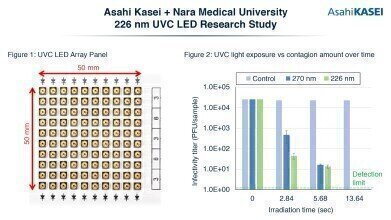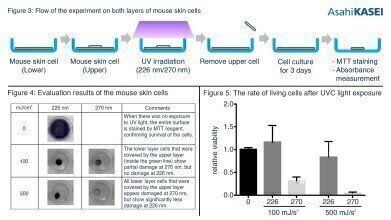News & Views
Study confirms efficacy of 226nm UVC LEDs against SARS-CoV-2
Jun 23 2021
The results of joint research project regarding the efficacy of 226 nm ultraviolet-C (UVC) LEDs in the inactivation of the coronavirus (SARS-CoV-2) that causes COVID-19, and its effects on animal skin cells has been announced by Asahi Kasei. Conducted with Nara Medical University, Japan, this is the first study in the world conducted with LEDs of this wavelength, and the results confirm that the 226 nm UVC LEDs are able to quickly inactivate SARS-CoV-2 while having significantly less effect on animal skin cells than 270 nm UVC LEDs.
The inactivation (killing) of viruses and other pathogens using UV light rather than chemical disinfectants has drawn greater attention with the COVID-19 pandemic. Nevertheless, it has been necessary to prevent light from conventional mercury UV lamps (254 nm) and UVC LEDs (260–280 nm) from directly irradiating human skin due to risk of harmful effects. In contrast, UV excimer lamps with a wavelength of 222 nm were introduced last year showing negligible effect on the human body. However, LEDs are more compact and allow greater flexibility in design, have less risk of breaking, and have a quicker startup time than traditional lamps, opening up new potential for smaller, safer, and more responsive applications of UVC light.
Crystal IS, Inc, an Asahi Kasei company, has commercialised Klaran™ UVC LEDs in the 260–270 nm wavelength range, and is now supporting the advanced research by Asahi Kasei to reach shorter wavelengths. Recently, Asahi Kasei’s Corporate Research & Development was able to create 226 nm UVC LED prototypes, and tests with both 226 nm and 270 nm UVC LEDs were conducted regarding their efficacy for inactivating SARS-CoV-2 as well as their effects on animal skin cells. The test results showed that in approximately 6 seconds, 99.9% of COVID-19 was inactivated by both 226 nm and 270 nm UVC LEDs. In addition, the tests confirmed that the 226 nm UVC LED had significantly less of an effect on animal cells than 270 nm LEDs.
These results suggest the possibility that 226 nm UVC LEDs may be safely used to disinfect hands or objects where there are people nearby. Moving forward, further advancements in technology will be necessary before the power of the light emitted from 226 nm UVC LEDs can be improved enough for commercialisation. Continued research development by Asahi Kasei is progressing to make this possible.
More information online
Digital Edition
Lab Asia 31.2 April 2024
April 2024
In This Edition Chromatography Articles - Approaches to troubleshooting an SPE method for the analysis of oligonucleotides (pt i) - High-precision liquid flow processes demand full fluidic c...
View all digital editions
Events
Apr 22 2024 Marrakech, Morroco
Making Pharmaceuticals Exhibition & Conference
Apr 23 2024 Coventry, UK
Apr 23 2024 Kintex, South Korea
Apr 23 2024 Seoul, South Korea
Apr 24 2024 Jakarta, Indonesia









.jpg)









